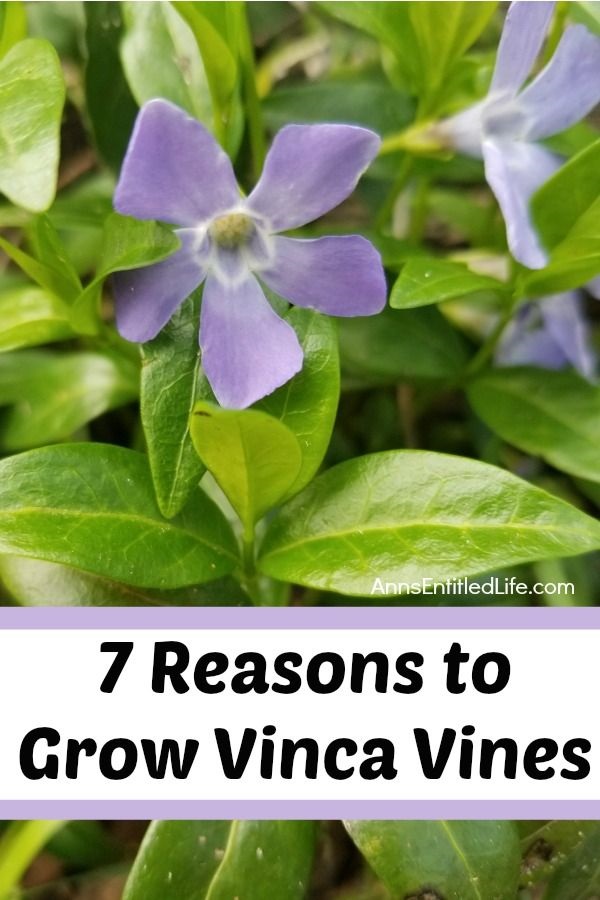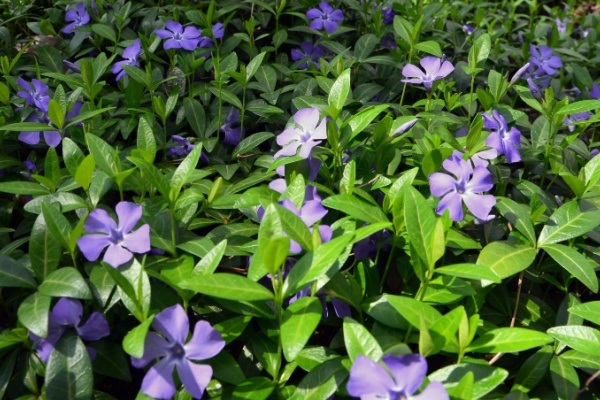Perennial Vinca vines sure do pack a garden punch. These little purple-blue flowers are beautiful and mighty, thriving even in less than ideal growing conditions. If you are looking for some colorful ground cover, vinca vines may be just the plant you are looking for. Read below for my 7 reasons to grow vinca vines and see what a great garden choice these little plants can be!
7 Reasons to Grow Vinca Vines
Years ago (like many, many years ago… ok, 25+ years ago) I bought vinca vines to use in my planters. Back then my budget was very, very tight, and I used inexpensive vincas to make my homemade planters look professional! They drape over the sides of planters and pots and look absolutely beautiful. They were sold as annuals in my local gardening center.
Well, I hated to toss them away, so I planted them on the side of my driveway to fill in the small dirt patch between my driveway and stockade fence (I lived in the city back then). Well, what do you know but not only did they survive, they thrived! Because the trailing vine vincas are actually perennials! I surmise they were labeled as annuals exactly because people used them in planters and considered them disposable plants.
Every year I would make up my container garden planters with flower annuals, vincas, and a spike, and every year I would save the vinca vines along the fence. By the time I moved 10 years later, they had nearly filled the whole area.
Now since the vinca vine continued to grow as if they were a trailing drape (remember, these are used frequently in container gardens in hanging baskets and planters as the “spillers”) twice per season I would haul out my gardening scissors and cut off the long trails that grew onto the driveway itself. They always came back beautifully.
I also planted a few in my landscape beds in the front yard. These plants grew well in full sunlight and in partial shade. They grew well in moist soil (not wet). They were a terrific plant to form a partial ground cover in my flower beds. They do not require much work; those beds were fertilized with a granulated starter fertilizer and then a slow-release fertilizer, covered in cocoa mulch, and new soil was added as needed. Pretty periwinkle ground cover surrounded my flower bed from early spring well into the summer.
Vinca minor (periwinkle flowers) is considered a tough, low-maintenance flower that is pest resistant and easy to grow. The vinca minor is an invasive species (an invasive plant).
The vinca major is a semi-evergreen ground cover plant that is considered an invasive species (an invasive plant). You do need to be aware of the spread of the plant and cut back accordingly.
Vinca generally grows well in zones 3, 4, 5, 6, 7, 8. Various types of vinca that best suit your climate will be sold at your local nursery. Note that perennials are generally sold in zones 7, 8, 9. I live in zone 6b and remember my perennial story. Check the USDA hardiness zone map to see if vinca will grow well in your area.
Vinca vines are an excellent choice for gardeners who like easy-to-grow plants and have large areas to cover and enjoy lovely ground cover Just be careful they do not become invasive. I do not suggest planting them in flower beds as pot-bound, but do keep track of the new shoots and roots so they do not take over your beds.
You can grow your vinca plants from seedlings you purchase at the nursery, from transplants, or vinca seeds.
There are several types of vinca. Note that they are different plants.
● PerennialPerennial Vinca – evergreen leaves, trailing vines, and blue flowers
● Annual Vinca – Catharanthus roseus, which is not a vine
Why you should grow vinca vines:
1. Vincas are cost-effective
You can find vinca vines for as little as a few dollars, making them a great investment for gardeners on a budget. Even better is if you can score some plants for free from someone who is digging them up. Check local Craigslist listings to see if there are any current offerings and possibly score some vincas for cheap or free.
2. Vincas will return yearly
The perennial variety is a hardy plant and will give you an excellent return rate. Once you plant it, you can count on it coming back in full force each spring and well into summer. In fact, it will not just come back but will multiply! The vinca vines do grow rapidly and multiply. Remember, it is considered an invasive species so keep a watch so it does not take over your garden beds.
3. Vincas do not mind shade
If you have a yard that is shady, you do not have to worry about your vincas. They do not require full sun and actually do well in part sun and shade. While you might not get as many blooms, you will still enjoy some and get nice and rich foliage.
4. Vincas require very little care
Vinca vines are a plant it and forget it type of plant. Once in the ground, they tend to do their own thing. You do not have to prune, deadhead the plants, or even do much in the way of watering. They seem to do well as long as you have regular rain showers and keep them in well-draining soil spots.
5. Vincas can be relocated
If your plants get out of control you can dig them up and move them. They are hardy plants and will transplant well. This is a great way to get “free” plants and landscape your yard for less. Who doesn’t love free plants?
6. You can enjoy all sorts of colors
Vincas produce tiny blooms in shades of white, purple, and pink. If you love color, you will find they offer a nice pop of it. In addition to looking great on trellis areas, fences, and borders, they also look great climbing out of flower pots, planters, and window boxes.
7. Hummingbirds and butterflies love Vincas
The bright colors of their flowers, as well as the shape, attract hummingbirds and butterflies. Their beaks and tongues fit into the flower perfectly allowing them to take a much-needed sip of nectar. Vincas help these pollinators by keeping them fed, which is reason enough to let them grow.
While there are annual varieties of vincas, the perennial varieties discussed here are ideal for easy gardening. Give them your consideration and see what a great plant they can be! In no time, you can be enjoying a yard full of beautiful vinca vines, too!
Planting a flower garden? You might want to read these great ideas:
● 5 Pest Repelling Plants While pesticides or insecticides may have their place, most gardeners would prefer to keep insects and rodents out of the garden as naturally as possible. There are natural, organic methods, and better yet, plants that repel pests.
● 75 Acid Loving Plants – If you have acidic soil, you need plants that flourish within an acid soil environment. Flowers, vegetables, shrubs, and trees all have specific soil needs; these 75 acid-loving plants are great choices for your gardening and landscaping needs.
● Why Your Garden Needs Nasturtiums – There are just some plants that should be grown in every garden. Nasturtiums are one such plant!
● For more Gardening posts on Ann’s Entitled Life, click here.
● If you enjoyed this post, be sure to sign up for the Ann’s Entitled Life weekly newsletter, and never miss another article!


Native Plant Jane says
This is terrible advice! Vincas are an extremely invasive plant that will take-over your landscape and is nearly impossible to remove. Do not plant it in the ground ever. Period.
Kentucky Wonder says
Native Jane,
I’m not sure I agree with your comment. For example, if one lives with a clay slope across the back of one’s property, Vinca is a great solution. One must monitor and trim accordingly. It’s all about thoughtfulness and care.
Like most things in real life, plants are rarely “one size fits all” or “one and done.”
Kentucky Wonder